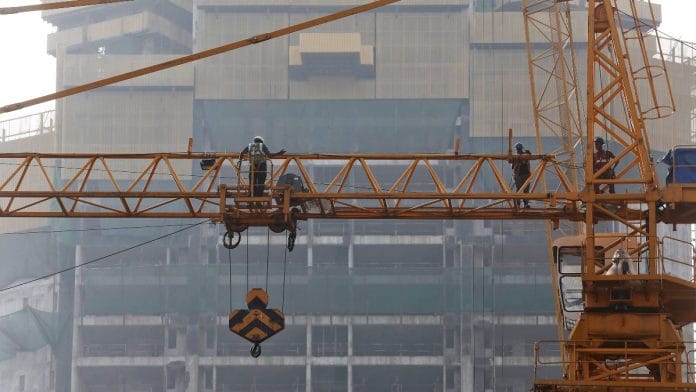Mumbai: The Maharashtra government has estimated that to complete all planned public infrastructure projects in Mumbai, it will need at least 50,000 tenements to rehabilitate all the affected residents. Additionally, the various planning and development agencies in Mumbai will need another 2.2 lakh houses to fully implement the city’s development plan, ThePrint has learnt.
With those targets in front of it, the state housing department has created a policy to generate more housing stock and swiftly allot alternative accommodation to all those displaced due to infrastructural work in Mumbai. The planning, officials in the state housing department said, is essential to ensure projects don’t stall or become costlier due to the challenges of rehabilitating a large number of people.
“The 2.2 lakh-plus-50,000 houses is a ballpark dynamic figure, but while implementing any project in Mumbai or its suburbs, it is impossible that no livelihoods or homes would be impacted. If the rehabilitation of project-affected people is not done on time, it will be difficult to secure their support for the project,” Valsa Nair Singh, additional chief secretary in charge of Maharashtra’s housing department, told ThePrint.
“So, we are planning ahead to see how any additional housing stock generated can be brought to use for this purpose and how we can generate more housing stock for this,” he said.
Under the policy, which ThePrint has seen, the state government has proposed additional incentives for developers in exchange for housing stock; following up with relevant agencies to unlock vacant lands in the salt pans and under the Mumbai Port Trust; and using some of the houses in the permanent transit camps as alternative permanent accommodation for affected residents, among other suggestions.
Singh added that the policy, which was released in the public domain last week, was passed in the state cabinet last month, and the state urban development department just needs to issue a few notifications to implement the policy.
Also Read: Technical changes, delays push cost of Bandra-Versova Sea Link up by over 140% in 7 yrs
Plan to generate additional housing stock
The state housing department’s policy comes after a petition that was filed in 2023 in the Bombay High Court on the delays in completing the infrastructure projects in Mumbai because of the time taken to rehabilitate those affected by the construction.
The court directed the government to draft a policy on the rehabilitation of the affected residents, following which the state government in November 2023 established a task force, headed by a retired judge, to study the issue and give suggestions. The task force submitted its report to the government in January this year. The state housing department finalised its policy based on the recommendations made by the task force.
To begin with, the policy directs all development agencies working in Mumbai such as the Brihanmumbai Municipal Corporation (BMC), the Mumbai Metropolitan Region Development Authority (MMRDA) and the Slum Rehabilitation Authority (SRA) to submit a report on how many tenements they will need to complete their projects in the next three-five years and how they plan to generate this stock.
The policy also mandates that all additional houses built under various schemes—such as the redevelopment of cessed buildings (old buildings that pay a cess to the Maharashtra Housing and Area Development Authority for maintenance), cluster redevelopment and slum redevelopment—to be added to the tally of the housing stock required to complete infrastructure works and implement Mumbai’s Development Plan.
The SRA is required to flag slum redevelopment projects to the MMRDA and BMC where the sale component of the project can be purchased by the agencies at an affordable rate. These tenements can then be added to the stock for the rehabilitation of affected residents.
According to the policy, the urban development department is expected to follow up with concerned agencies to unlock public land, salt pan lands, and land under the Mumbai Port Trust so that additional housing stock can be built there.
Incentives to developers, distributing tenements online
As part of the policy, the state government also plans to relook at the Transferable Development Rights (TDR), and, particularly, a provision under the slum rehabilitation scheme where the owner of a vacant unencumbered plot can use the land to construct tenements for development project-affected residents and is compensated by TDR for the land and construction. The idea, officials said, is to incentivise developers to take up more such projects.
TDR allows the transfer of the unused development potential of a plot to use elsewhere in zones of the city that are not fully developed.
The developer undertaking a redevelopment project will also be allowed to club any adjacent vacant public plot after getting a no-objection certificate from the public agency that owns the land to create additional housing stock and get TDR in return, the policy says.
The developer will also get the option of providing housing stock to the government instead of paying the multiple premiums required in slum redevelopment projects.
Under the policy, the state government has asked the BMC and MMRDA to develop an online system for distributing tenements to development and infrastructure project-affected residents. Orders allocating houses to eligible residents displaced by any project will be valid for 45 days—the displaced residents are expected to vacate their houses and take charge of the new tenement within this time.
The policy mandates that the alternative houses offered to affected people should be around the same location. However, if that is not possible, the allotted alternative houses should at least be in an adjacent ward or the same zone. It also mandates that once the displaced residents are allotted houses, they cannot be sold for at least five years.
(Edited by Sanya Mathur)
Also Read: Unique numbers to 3D mapping, Dharavi survey picks up steam, but project’s fate hangs in balance






